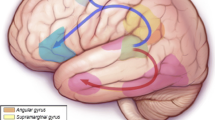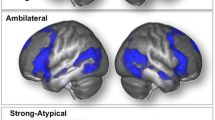Abstract
This study analyzed specificities in the activity of the neurophysiological mechanisms underlying the organization of active word-derivation processes. The regularities in the reorganization of the spatial structure for the systemic interaction of bioelectrical activity between different cortical areas of the cerebral hemispheres were studied in adult subjects during the test for mental derivation of common root words (i.е., using the modern methods of the so-called “functional connectome” investigations). Сross-correlation and coherent analysis of EEG has shown that the ipsilateral statistical EEG interactions in the left hemisphere, including Broca’s and Wernicke’s areas, were significantly increased in adults during mental derivation of common root words and, simultaneously, the interhemispheric connectivity and the EEG interactions in the right hemisphere were reduced. Comparison of our results with the previous data of verbal activity associated with speech perception and production has revealed significant differences in the degree of involvement of the left and right hemisphere cortical activity in verbal processing. For example, unlike the data of current study, an equal involvement of both hemispheres cortical activity was recorded during the phoneme recognition in auditory perceived words, grammatical and semantic errors in sentences, as well as during mental formation of words from a set of phonemes and sentences from a set of words, which was particularly manifested in the increased of hemispheric interactions, predominantly, in the inferior frontal and temporal areas and the overlapped areas of the temporal, parietal, and occipital cortical zones (TPO) of both hemispheres. Thus, the data obtained in this study indicate the presence of expressed specificities in the lateralization of activity in the neurophysiological mechanisms underlying the processes of active word derivation and inflexion.
Similar content being viewed by others
References
Sporns, O., Tononi, G., and Kötter, R., The human connectome: a structural description of the human brain, PLoS Comput. Biol., 2005, vol. 1, no. 4, p. 42.
Hagmann, P., Kurant, M., Gigandet, X., et al., Mapping human whole-brain structural networks with diffusion MRI, PLoS One, 2007, vol. 2, no. 7, p. 597.
Bola, M. and Sabel, B.A., Dynamic reorganization of brain functional networks during cognition, Neuroimage, 2015, vol. 114, p. 398.
Hickok, G. and Poeppel, D., Towards the functional neuroanatomy of speech perception, Trends Cognit. Sci., 2000, vol. 4, no. 4, p. 131.
Saur, D., Kreher, B.W., Schnell, S., et al., Ventral and dorsal pathways for language, Proc. Natl. Acad. Sci. U.S.A., 2008, vol. 105, no. 46, p. 18035.
Poeppel, D., Emmorey, K., Hickok, G., and Pylkkänen, L., Towards a new neurobiology of language, J. Neurosci., 2012, vol. 32, no. 41, p. 14125.
Specht, K., Mapping a lateralization gradient within the ventral stream for auditory speech perception, Front. Hum. Neurosci., 2013, vol. 2, no. 7, p. 629.
Tsitseroshin, M.N. and Shepoval’nikov, A.N., Stanovlenie integrativnoi funktsii mozga (Formation of Integrative Function of the Brain), Bechtereva, N.P., Ed., St. Petersburg: Nauka, 2009.
Shepovalnikov, A.N. and Tsitseroshin, M.N., Formation of interzonal interaction of cortical fields during verbal-mental activity, J. Evol. Biochem. Physiol., 2004, vol. 40, no. 5, p. 411.
Ivonin, A.A., Tsitseroshin, M.N., Pogosyan, A.A., and Shuvaev, V.T., Genetic determination of neurophysiological mechanisms of cortical-subcortical integration of bioelectrical brain activity, Neurosci. Behav. Physiol., 2004, vol. 34, no. 4, p. 369.
Klimash, A.V., Tsitseroshin, M.N., Shepovalnikov, A.N., Zajceva, L.G., Kondakov, E.N., and Borovikova, V.N., Disorders of the spatiotemporal organization of the brain’s bioelectrical activity in patients with different depressions of consciousness after severe head injury, Hum. Physiol., 2010, vol. 36, no. 5, p. 535.
Weiss, S. and Mueller, H.M., The contribution of EEG coherence to the investigation of language, Brain Lang., 2003, vol. 85, no. 2, p. 325.
Chernigovskaya, T.V., The mirror brain, concepts, and language: the price of anthropogenesis, Ros. Fiziol. Zh. im. I.M. Sechenova, 2006, vol. 92, no. 1, p. 84.
Dehaene-Lambertz, G., Dehaene, S., and Hertz-Pannier, L., Functional neuroimaging of speech perception in infants, Science, 2002, vol. 298, no. 5600, p. 2013.
Slioussar, N., Kireev, M.V., Chernigovskaya, T.V., et al., An ER-fMRI study of Russian inflectional morphology, Brain Lang., 2014, vol. 130, p. 33.
Leont’ev, A.A., Osnovy psikholingvistiki (Fundamentals of Psycholinguistics), Moscow: Smysl, 1997.
Vigneau, M., Beaucousin, V., Herve, P.Y., et al., Metaanalyzing left hemisphere language areas: phonology, semantics, and sentence processing, Neuroimage, 2006, vol. 30, p. 1414.
Price, C.J., A review and synthesis of the first 20 years of PET and fMRI studies of heard speech, spoken language and reading, Neuroimage, 2012, vol. 62, no. 2, p. 816.
Ross, E.D., Cerebral localization of functions and the neurology of language: Fact versus fiction or is it something else? Neuroscientist, 2010, vol. 16, no. 3, p. 222.
Simernitskaya, E.G., Mozg cheloveka i psikhicheskie protsessy v ontogeneze (The Human Brain and Mental Processes in Ontogenesis), Moscow: Mosk. Gos. Univ., 1985.
Božić, M., Tyler, L.K., Ives, D.T., et al., Bihemispheric foundations for human speech comprehension, Proc. Natl. Acad. Sci. U.S.A., 2010, vol. 107, no. 40, p. 17439. doi 10.1073/pnas.1000531107
Davis, M.H. and Johnsrude, I.S., Hierarchical processing in spoken language comprehension, J. Neurosci., 2003, vol. 23, no. 8, p. 3423.
Božić, M., Szlachta, Z., and Marslen-Wilson, W.D., Cross-linguistic parallels in processing derivational morphology: evidence from Polish, Brain Lang., 2013, vol. 127, no. 3, p. 533.
Whiting, C.M., Marslen-Wilson, W.D., and Shtyrov, Y., Neural dynamics of inflectional and derivational processing in spoken word comprehension: laterality and automaticity, Front. Hum. Neurosci., 2013, vol. 7, p. 759.
Leminen, A., Leminen, M., Lehtonen, M., et al., Spatiotemporal dynamics of the processing of spoken inflected and derived words: a combined EEG and MEG study, Front. Hum. Neurosci., 2011, vol. 5, p. 66.
Service, E. and Maury, S., Differential recall of derived and inflected word forms in working memory: examining the role of morphological information in simple and complex working memory tasks, Front. Hum. Neurosci., 2015, vol. 8, p. 1064. doi 10.3389/fnhum.2014.01064
Danko, S.G., Boytsova, J.A., Solovjeva, M.L., Chernigovskaya, T.V., and Medvedev, S.V., Eventrelated brain potentials when conjugating Russian verbs: The modularity of language procedures, Hum. Physiol., 2014, vol. 40, no. 3, p. 237.
Kireev, M., Slioussar, N., Korotkov, A., et al., Changes in functional connectivity within the fronto-temporal brain network induced by regular and irregular Russian verb production, Front. Hum. Neurosci., 2015, vol. 9, p. 36. doi 10.3389/fnhum.2015.00036
Marangolo, P., Piras, F., Galati, G., and Burani, C., Functional anatomy of derivational morphology, Cortex, 2006, vol. 42, no. 8, p. 1093.
Tsaparina, D.M. and Shepoval’nikov, A.N., The role of interhemispheric interaction in the process of identifying errors in the verbal material, Sens. Sist., 2004, vol. 18, no. 2, p. 160.
Tsitseroshin, M.N., Tsaparina, D.M., and Zajceva, L.G., The role of the interhemisphere interactions in children aged 5–6 years and adults in supporting verbal-mnestic activity associated with the formation and analysis of verbal utterances, Neurosci. Behav. Physiol., 2013, vol. 43, no. 7, p. 799.
Tsaparina, D.M., Tsitseroshin, M.N., and Shepovalnikov, A.N., Age-related characteristics of the formation of neurophysiological mechanisms of the phonemic, grammatical, and semantic linguistic levels, Hum. Physiol., 2008, vol. 34, no. 5, p. 546.
Booij, G., Inflection and derivation, in Encyclopedia of Language and Linguistics, Brown, K., Ed., Oxford: Elsevier, 2005, p. 83.
Slioussar, N., Kireev, M.V., Chernigovskaya, T.V., et al., An ER-fMRI study of Russian inflectional morphology, Brain Lang., 2014, vol. 3, no. 130, p. 33.
Hanna, J. and Pulvermüller, F., Neurophysiological evidence for whole form retrieval of complex derived words: a mismatch negativity study, Front. Hum. Neurosci., 2014, vol. 6, no. 8, p. 886.
Author information
Authors and Affiliations
Corresponding author
Additional information
Original Russian Text © D.M. Guillemard (Tsaparina), M.N. Tsitseroshin, L.G. Zajtseva, L.Y. Tsaparina, E.A. Panasevich, 2018, published in Fiziologiya Cheloveka, 2018, Vol. 44, No. 2, pp. 22–30.
Rights and permissions
About this article
Cite this article
Guillemard (Tsaparina), D.M., Tsitseroshin, M.N., Zajtseva, L.G. et al. Organization of Regional Interactions of the Brain Cortical Activity during the Common-root Word Derivation Task. Hum Physiol 44, 134–142 (2018). https://doi.org/10.1134/S036211971802007X
Received:
Published:
Issue Date:
DOI: https://doi.org/10.1134/S036211971802007X




